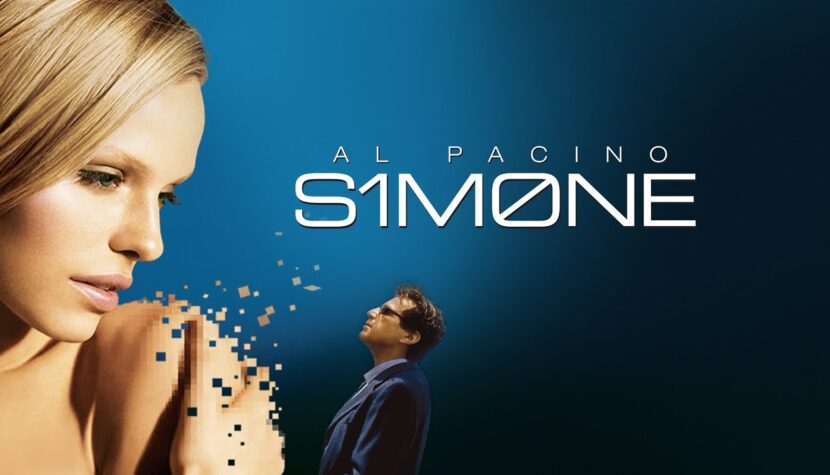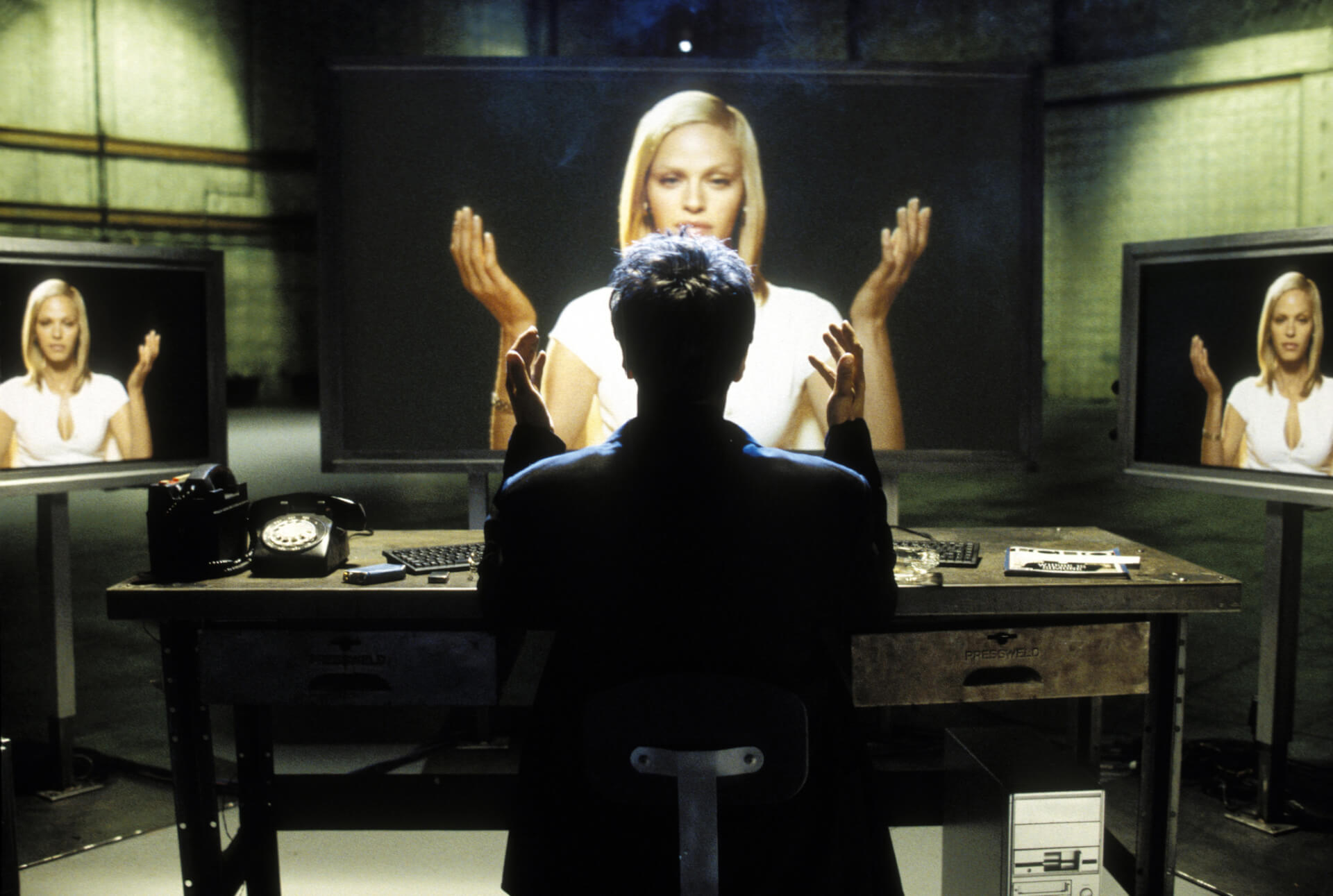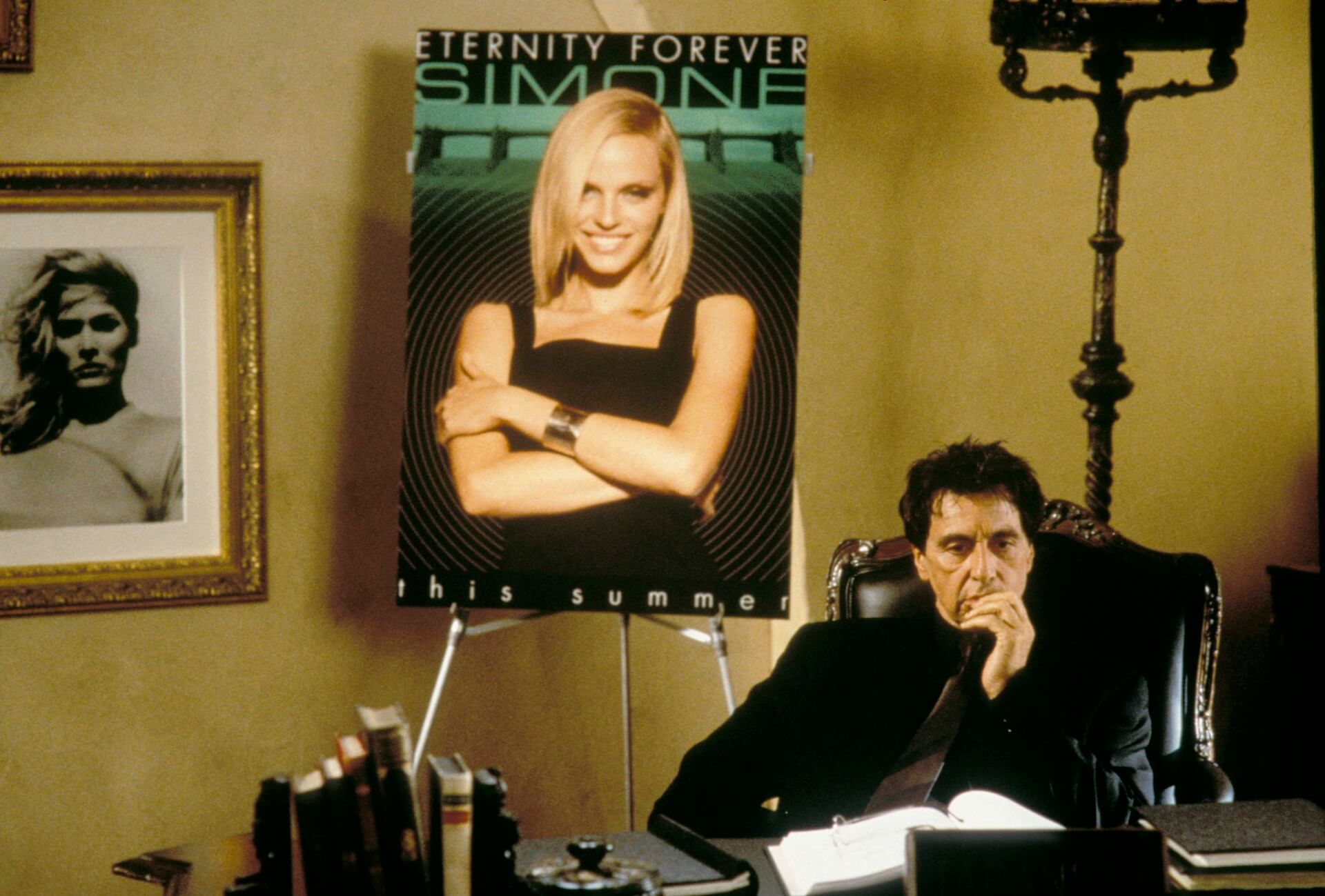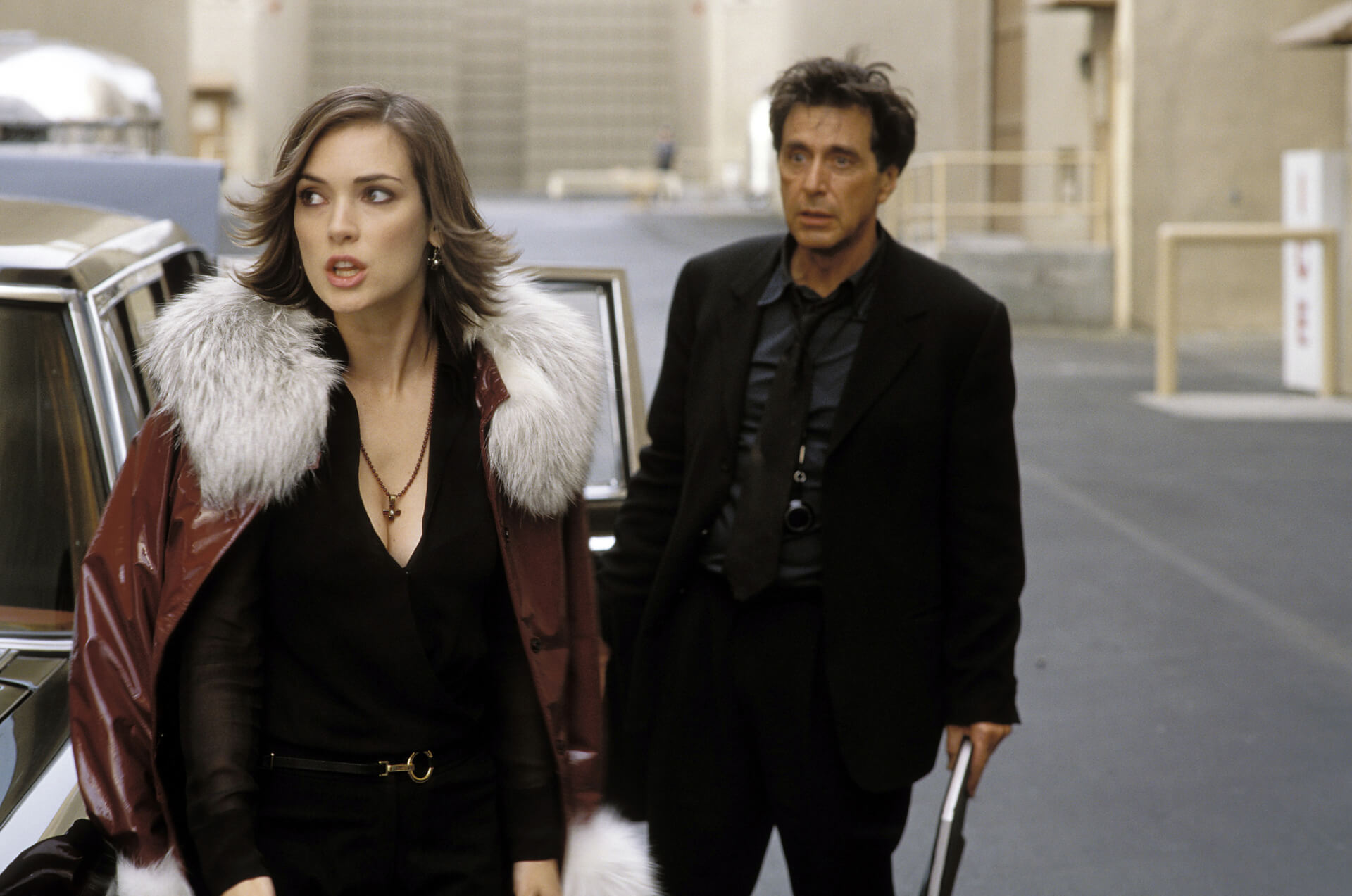S1M0NE / SIMONE. Bitterly ironic piece of science fiction

Later, the Lumiere brothers’ film of a train entering a station caused the audience to flee from the first movie projection. This amusing episode dismantled the bridge between life and illusion. In People’s Poland, there was a saying that the only true information in “Trybuna Ludu” (a newspaper) was the date. Media became a powerful means, shaping the awareness of the audience. In the political grotesque “Wag the Dog,” played by Robert De Niro with disarming cynicism, explained the mechanism of television information that could be manipulated at will. Currently, to a simple question, “- How do you know about this?” comes an even simpler answer, “- I saw it on TV.” Electronic communication technology has never been so close to the concerns of sociologists. The means of information itself has become information, blindly purchased by perpetually rushing audiences.
I created S1m0ne (Simone).
No, she created you.
Cinema, possessing the power to create entire worlds, is currently on the best path to producing a perfect illusion. George Lucas, Peter Jackson, Ridley Scott, James Cameron, and many other masters, thanks to digital technology, can take the viewer to lands that are impossible to visit otherwise. Computers have already overcome the barrier of generating an artificial character, although the perfection of digitally animated people still lacks the proverbial divine spark breathed into lifeless pixels. But what if that barrier were crossed?
Director Viktor Taransky had no ambition to seduce viewers with visions of new nonexistent worlds. He just wanted to make good, ambitious contemporary cinema. However, in the American system, controlled by major studios, there is no room for the artistic whims of directors. Those belong to actors, or rather, to stars who receive hefty millions for a role. The director can be reduced to a servant for the star, which happened to poor Viktor. Crushed by the departure of a mannered starlet, abandoned by everyone, with an unfinished film, Taransky is left without a job. One day, the dying mad scientist Hank Aleno visits him, handing over a hard disk with the computer program Simulation One, designed to create a virtual actress.

Taransky completes the film by inserting Simone, a digital creation of Simulation One, into the recorded scenes. Suddenly, the whole world goes crazy. Previously unknown, ethereal, and captivating Simone becomes a sensation, surpassing the world of film. Everyone wants to see her, get to know her, touch her, talk to her. Simone appears on the covers of top color magazines, releases an album, gives interviews, and simultaneously fiercely guards her privacy, much to the dissatisfaction of fans. But no one knows that Simone doesn’t exist at all, that she is just a collection of ones and zeros, completely controlled by the power-enjoying demiurge Viktor. But this joyful manipulation soon backfires on the director…
Simone (or S1m0ne, as some prefer) is the fulfillment of a director’s dream. How many creators had to bend their visions to the demands of producers and the whims of stars? If an actor doesn’t fit, you can just replace them, right? No! Only a few can afford it (like Kubrick, who removed all scenes with Harvey Keitel from Eyes Wide Shut and re-shot them with Sydney Pollack). Such carte blanche is rare. David Lynch, despite Oscar nominations for The Elephant Man, had to work under producer dictation on the set of Dune, and Paul Schrader was fired during the production of the prequel to The Exorcist and replaced by Renny Harlin. Hollywood’s daily bread. Simone is the creator’s yearning for a situation where he will be the undisputed ruler of the film set and the promotional hullabaloo. Without production bosses turning off the money tap, without script revisions made on the side by hired “script doctors,” without being deprived of the right to final editing, and above all, without capricious stars, trampling over creators in the name of misunderstood luxury.

But the entire comedic aspect of the film, with Al Pacino playing his role superbly, takes a back seat. The main character of Simone is the audience, enthralled by the titular heroine. The writer, producer, and director (the fulfilled dream of power over the film?) is Andrew Niccol, a New Zealander. After his debut Gattaca (1997), he came up with Truman Burbank, an unwitting participant in a reality show, in Peter Weir’s phenomenal The Truman Show from 1998. Watching Simone, one cannot resist the obvious similarities to Andrew Niccol’s creative method presented in The Truman Show. In both films, Niccol doesn’t care about the slow (and very cinematic) unveiling of secrets. The viewer immediately gets information about who is deceiving, who is being deceived, and who is pulling the strings. Building their unreal worlds, the creator presents them as something entirely normal and familiar to viewers. The sociotechnical vivisection is much more interesting, applied from the big and small screens.

**WARNING – SPOILERS!!**
The deceived-deceiver direction, however, has been reversed. The narrative engine of The Truman Show was the search for truth and the escape from the phantasmagorical world by the hero, wonderfully played by Jim Carrey. Although we laughed at the viewers of this absurd soap opera, we still identified with them when we anxiously cheered for Truman, fighting the storm. The only loser was Christof, posing as the god of this artificial world. This happy ending was, however, ambiguous. Did the audience become wiser and genuinely wish good for their idol? After all, his success automatically meant the end of their favorite reality show. But just switch to another channel…
And now, imagine that on another channel, a new deity is born—Simone, of unearthly beauty, whose charm can ignite even asbestos. Her admirers live in the same world that surrounded Seahaven (the city-studio where Truman lived). In Simone, we also have a happy ending, and it is just as mocking. Viewers are not led out of the illusion, and Viktor Taransky regains his wife along with his daughter and continues happily feeding the bewildered viewers with media nonsense.
**END OF SPOILERS**

Niccol’s diagnosis is merciless this time. The viewer simply wants to be deceived. Viktor Taransky cannot convince his wife or the police that Simone is a computer creation. At this point, the overarching function of film and television production as a waking dream, where we can safely experience our greatest dreams and worst nightmares, becomes apparent. With excitement, we read nonsense about celebrities’ plastic surgeries, stupidly laugh at Jennifer Lopez’s big buttocks, bet on who Eminem will offend this week, calculate the day when Michael Jackson’s nose will fall off, and wonder which tattooed idiot has not yet conquered Pamela Anderson. The colorful life of stars has become a substitute for dull everyday life. An idol is needed at any cost. And once we love them, we forgive them everything. Viktor Taransky wanted to destroy Simone’s fame by producing a film with his digital beauty dressed in a wedding gown and rolling in the mud among pigs. He prepares interviews with Simone, praising drugs. The result: Simone became Woman of the Year, and her subversive image was enthusiastically received as an important social voice, to the chagrin of the narrow-minded. Where do we know this from? The film industry bows, but not only that. When Gaspar Noe expelled his abomination titled Irreversible, so-called serious critics appreciated the carnage, attaching to it the safe label of a “bold work pushing boundaries.” But Mel Gibson couldn’t count on innovative splendors when The Passion was reduced to a “shocking display of bloody pulpits.” One bloody massacre is acceptable, and the other is not? After all, in both films, violence is extreme and difficult to watch. Andrew Niccol’s film, under the guise of a scifi comedy, leaves no illusions about human nature. Devourers of colorful images will consume and believe anything, as long as it’s packaged in a beautiful body or catchy ideology.

A few interesting facts. To keep the titular character a secret, pre-premiere materials contained digitally manipulated images of Simone. The role was played by 24-year-old Canadian model Rachel Roberts. It was her first film role, which made it easier for Niccol to sell the lie to journalists about a completely digital actress playing a digital character. Her credentials only appeared in the end credits in the DVD edition. In the Oscar gala scene, Simone’s contenders carry names from the computer industry: Lotus Corel, Claris Apple, and Lisa Packard. Al Pacino received the name for his character after Victor Frankenstein – no need to explain why. In several scenes, a live copy of Simone was played by Rebecca Romijn-Stamos (X-Men, Femme Fatale), who really looked like Rachel Roberts’ sister. In the film, the synchronization of Al Pacino’s speech with Rachel appearing on the screen played an important role. After many attempts, they finally decided to digitally insert Rachel into the frame instead of shooting the entire scene live. Eight companies worked on the excellent visual effects.

Simone is an example of a comedy offering laughter tinged with bitter irony (in the concert sequence, Simone sings a song titled “You make me feel like a natural woman”). Andrew Niccol smoothly portrays the image of a modern consumer of media products. Whether it’s a housewife or a serious critic, anyone can be led astray. Skeptics may scoff at the comedic tone, obscuring a more serious attempt at sociological analysis and a few unbelievable plot twists. Well, Simone is still science fiction. For Truman Show enthusiasts, it’s a must-see.

